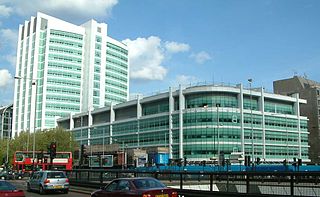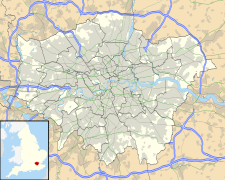
University College Hospital (UCH) is a teaching hospital in the Fitzrovia area of the London Borough of Camden, England. The hospital, which was founded as the North London Hospital in 1834, is closely associated with University College London (UCL), whose main campus is situated next door. The hospital is part of the University College London Hospitals NHS Foundation Trust.

Whittington Hospital is a district general and teaching hospital of UCL Medical School and Middlesex University School of Health and Social Sciences. Located in Upper Holloway, it is managed by Whittington Health NHS Trust, operating as Whittington Health, an integrated care organisation providing hospital and community health services in the north London boroughs of Islington and Haringey. Its Jenner Building, a former smallpox hospital, is a Grade II listed building.

Hillingdon Hospital is a hospital in Hillingdon, London. It is one of two hospitals run by The Hillingdon Hospitals NHS Foundation Trust, the other being Mount Vernon Hospital.

Southmead Hospital is a large public National Health Service hospital, situated in the area of Southmead, though in Horfield ward, in the northern suburbs of Bristol, England. It is part of the North Bristol NHS Trust. The 800-bed Brunel Building opened in May 2014, to provide services, which transferred from Frenchay Hospital in advance of its closure. The hospital site covers 60 acres (24 ha).

Hammersmith Hospital, formerly the Military Orthopaedic Hospital, and later the Special Surgical Hospital, is a major teaching hospital in White City, West London. It is part of Imperial College Healthcare NHS Trust in the London Borough of Hammersmith and Fulham, and is associated with the Imperial College Faculty of Medicine. Confusingly the hospital is not in Hammersmith but is located in White City adjacent to Wormwood Scrubs and East Acton.

Chase Farm Hospital is a hospital on The Ridgeway, in Gordon Hill, Enfield, run by the Royal Free London NHS Foundation Trust.

Bedford Hospital is a 400-bed district general hospital located in the English town of Bedford, serving the Borough of Bedford and parts of Central Bedfordshire, run by the Bedfordshire Hospitals NHS Foundation Trust.

Croydon University Hospital, known from 1923 to 2002 as Mayday Hospital and from 2002 to 2010 as Croydon Hospital, is a large NHS hospital in Thornton Heath in south London, England run by Croydon Health Services NHS Trust. It is a District General Hospital with a 24-hour Accident and Emergency department. The hospital is based on a 19-acre (7.7 ha) site in Thornton Heath to the north of central Croydon.

Ealing Hospital is a district general NHS hospital, part of London North West University Healthcare NHS Trust, located in the Southall district of the London Borough of Ealing, West London, England. It lies on the south side of the Uxbridge Road 8.5 miles west of central London. It sits between Southall town centre to the west and Hanwell to the east. It is built on land that was once part of St Bernard's Hospital which is run by West London Mental Health (NHS) Trust. The Ealing Hospital Interchange bus station is adjacent to the hospital.

West Middlesex University Hospital (WMUH) is an acute NHS hospital in Isleworth, West London, operated by Chelsea and Westminster Hospital NHS Foundation Trust. It is a teaching hospital of Imperial College School of Medicine and a designated academic health science partner. West Middlesex University Hospital serves patients in the London Boroughs of Hounslow, Richmond upon Thames and Ealing. The hospital has over 400 beds and provides a full range of clinical services including accident and emergency, acute medicine, care of the elderly, surgery and maternity.

Central Middlesex Hospital is in the centre of the Park Royal business estate, on the border of two London boroughs, Brent and Ealing. It is managed by the London North West University Healthcare NHS Trust.

Ipswich Hospital is a large district general hospital in Heath Road, Ipswich, Suffolk, England. It is now managed by East Suffolk and North Essex NHS Foundation Trust which was formed on 1 July 2018 by the merging of Ipswich Hospital NHS Trust with Colchester Hospital University NHS Foundation Trust.

The Northern General Hospital is a large teaching hospital and Major Trauma Centre in Sheffield, England. Its departments include accident and emergency for adults, with children being treated at the Sheffield Children's Hospital on Western Bank. The hospital is managed by the Sheffield Teaching Hospitals NHS Foundation Trust.

Newcastle General Hospital (NGH) was for many years the main hospital for the city of Newcastle upon Tyne, England. As part of Newcastle upon Tyne Hospitals NHS Foundation Trust moving from three to two key sites, the hospital was closed and the majority of services transferred to the city's other two hospitals, the Royal Victoria Infirmary and the Freeman Hospital. The Accident and Emergency Department and Intensive Care closed on 16 November 2010. A walk-in centre for minor ailments and injuries remained on the site.

East Lancashire Hospitals NHS Trust is an NHS hospital trust in Lancashire, England. It was established on 1 September 2002, as the result of a locally controversial, cost saving merger of Blackburn Hyndburn & Ribble Valley NHS Trust and Burnley Health Care NHS Trust, first announced in September 1999.

University Hospital Lewisham is a teaching hospital run by Lewisham and Greenwich NHS Trust and serving the London Borough of Lewisham. It is now affiliated with King's College London and forms part of the King's Health Partners academic health science centre. It is situated on Lewisham High Street between Lewisham and Catford.

Portsmouth Hospitals University NHS Trust is an NHS trust which provides healthcare services to Portsmouth and surrounding areas of Hampshire, and select services to a wider area. It runs the Queen Alexandra Hospital.
Healthcare in London, which consumes about a fifth of the NHS budget in England, is in many respects distinct from that in the rest of the United Kingdom, or England.
London North West University Healthcare NHS Trust is an NHS trust based in London, United Kingdom. The trust was formed by the merger of North West London Hospitals NHS Trust and Ealing Hospital NHS Trusts in October 2014.

North Middlesex University Hospital NHS Trust was an NHS trust which runs North Middlesex University Hospital in Edmonton, London and community services in Enfield. The trust serves more than 350,000 people living in the London boroughs of Enfield and Haringey, as well as the nearby boroughs of Barnet and Waltham Forest.



















